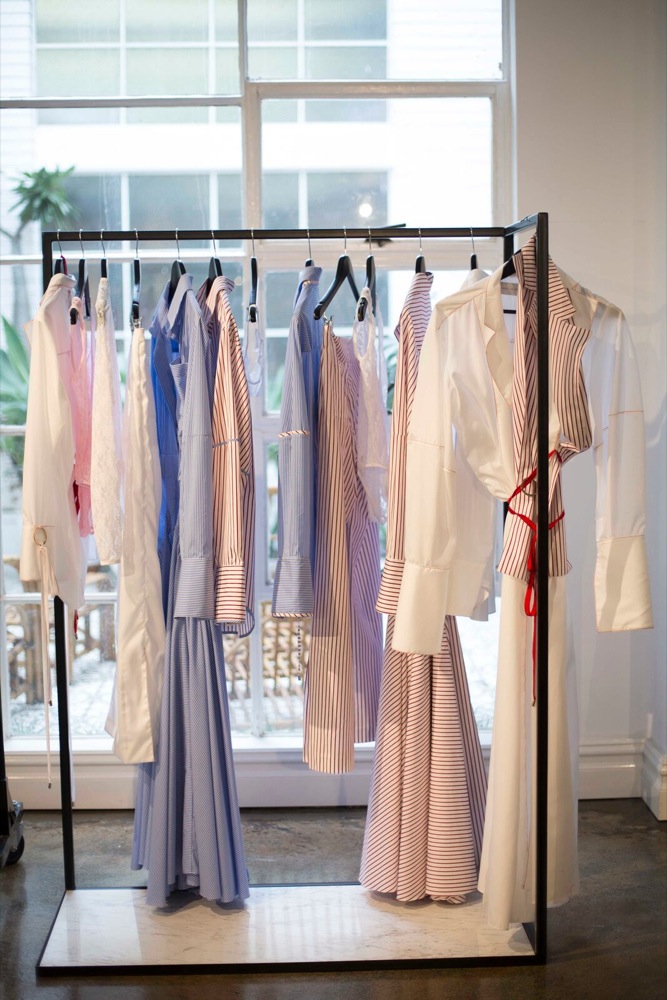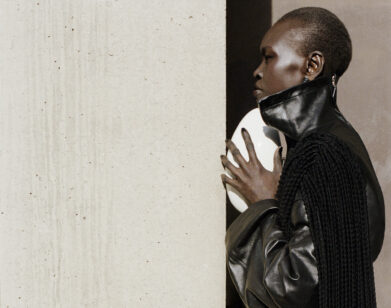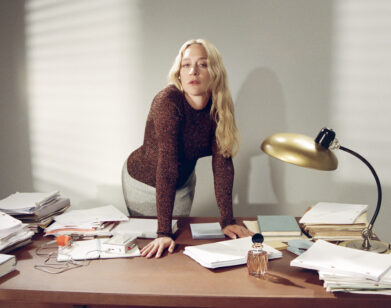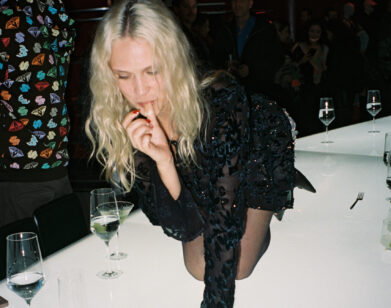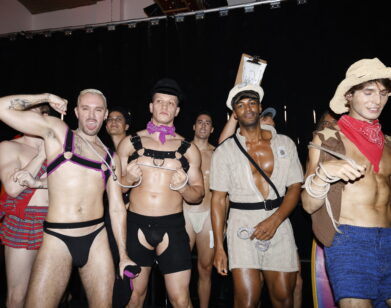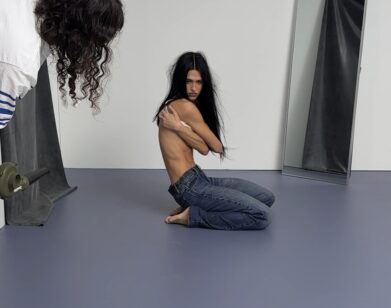Michael Lo Sordo
PHOTOS: NATE PALMER.
If Michael Lo Sordo had to pick a favorite look from his Resort 2018 collection, he might choose his rich red suits. “You gravitate towards certain pieces,” he explains when we meet him in Sydney a few days after his runway show at Mercedes Benz Fashion Week Australia. “Also the last look, which was this black, long-sleeved dress. It was so suggestive with the red stocking,” he continues. “You knew she was naughty, that she wanted to get up to something. I loved playing on that. I had so much fun with this collection.”
Though he was born in Sydney, Lo Sordo’s Italian family background heavily influenced his upbringing. “On the weekends, we’d stomp on tomatoes at my grandmother’s house and make tomato paste,” he tells us. Initially, the designer hoped to become a chef, enrolling in a culinary program before switching to fashion.
A decade into his eponymous label, Lo Sordo counts Net-a-Porter and Selfridges among his stockists. He favors natural fibers in his designs, and isn’t afraid of a little sex appeal, even if it leads to the occasional “red carpet” accusation. “I didn’t want to become a red carpet designer and be put in that box,” he remarks, “but it’s so much fun.”
EMMA BROWN: I read that you originally wanted to be a chef.
MICHAEL LO SORDO: I did enroll myself into a culinary course. The campus was part culinary, part arts, and there was a fashion section. I would see these fashion kids every day, and this was before fashion became cool and everyone wanted to be a designer. I kept seeing these cool kids being who they wanted to be, dressing eccentrically. I’ve always had that artistic energy inside of me, but I guess the safe route was becoming a chef. I wanted to open up a restaurant. But then something clicked in me and I deregistered that day and reregistered for the fashion course. I got in and haven’t looked back.
BROWN: Was your lack of experience an issue at all when you applied?
LO SORDO: I could draw, which was a big of the aspect of the course. As I grew with the course, I could see these hidden talents come out, like my love for fabrications. It allowed me to express myself.
BROWN: Then your graduate collection was sold at a pop-up shop in the Strand in Sydney, right?
LO SORDO: Yeah. We opened up a store called the Graduate Store. It was a collective with a couple of other designers. We were handed a set of keys and a lease, and then, “Bye-bye.” We did everything—the fit-out, organized all of that. It was nice to be thrown into that because I feel like I learn from making mistakes. Obviously there were challenges and you butt heads, but it was overall an amazing experience. We understood the retail side of things, the merchandising side of things. When I was doing that, I was also working for Giorgio Armani in visual merchandising, so I opened up all of the concept stores for him in Australia. It was great to have that background; I feel like it has helped me when I design my collections: “How’s it going to sit on the shop floor? Who’s the customer? Who’s buying it?” All those little things that he was so meticulous about.
BROWN: I also heard that your mother was a model.
LO SORDO: Yeah. I have these beautiful photos of my mother. When she was younger, she used to model in a clothing store back in Italy and then over here as well. I was always around it; I remember my mother dressing up and going out to those events, and she would put her perfume on from those bottles—little things like that stay with you. I actually did a pleated collection last Resort, which was inspired by a pleated dress that she wore all the time. She just loved it. Subconsciously, I feel like that comes through and I don’t have to try—it’s embedded in my head. My customers are the women that are around me, that have grown up around me. I have a twin sister and an older sister as well. I’ve been brought up by women, so I know what they want, what they feel. It was easy for me to understand that language between women and fashion.
BROWN: Did you ever consider doing menswear? Was that a part of your course at all?
LO SORDO: I would love to, but I feel like menswear is another language. It’s like learning Chinese. The cuts are different, the silhouettes are different, the proportions are different. I’ve made myself one coat in the 10 years that I’ve done fashion, and that was only last year. [laughs] Womenswear is exciting for me because I get to see that person that I love wearing it, and all of my role models seem to be women.
BROWN: How do you begin a new collection? Do you have to force yourself to sit down and come up with ideas? Or is it more that you have an idea that you just need to get out?
LO SORDO: I design not in the traditional way. I don’t sit and sketch and go, “This is inspired by Morocco.” Sometimes it’ll be unresolved ideas from another season that will pop up in my head, or a fabrication I saw that didn’t work for this season but that might work for the season after that. Genuinely, I love to drape, to put it on the mannequin, and if I have a model with me, put it on the model. I love to see the model move. The clothing for me is also about movement. We use a lot of natural fibers, like silk, cotton, Australian merino wool, silk-velvets. Two-dimension is different than three-dimension. I think it’s really important for me to not force myself to do things because that’s when I get nervous.
BROWN: Where do you get your fabrics?
LO SORDO: Silk is really a core of our collection. We have a beautiful factory in Shanghai that essentially makes everything. They’re clean to the environment, which I feel like is a great reflection on me—knowing that the beginning part of production is pure, so my clothes have a good aura. I know that sounds stupid, but I want it to channel through; when she wears it, I want her to feel amazing. We work a lot with Woolmark as well; I’ve been working with them for years and they’ve been supporting the brand for years, so I love to give back and showcase the quality of what Australian merino wool does for us.
BROWN: Does it feel like things are progressing at the speed you expected?
LO SORDO: I like to be in control of the speed. We’ve had to turn down clients before purely because of financial reasons, or because it wasn’t the right time, or it conflicted too much with another major [buyer]. It’s always been an organic growth for me, because I feel like I can control it that way and see what I want to do for the future as well. I’m here for the long-run, not for a short time.
BROWN: Have you ever walked passed someone wearing one of your designs on the street?
LO SORDO: I have a couple of times; it’s a little bit surreal. I was walking down the street in the City and I saw this 80-, 85-year-old woman and was wearing one of my white silk trench coats. She was just the chicest thing I’ve seen. I followed her for a second just to see which way she was going. I really love how people interpret the clothes for themselves, or for their lives; it’s really cool to see how the customer styles it themselves. I think it’s important [to have] individuality these days, with all this junk on Instagram. That, for me, is exciting to see as well.
FOR MORE ON MICHAEL LO SORDO, VISIT HIS WEBSITE.

